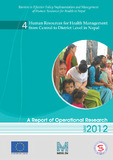Please use this identifier to cite or link to this item:
https://hdl.handle.net/20.500.14356/794| Title: | Human resources for health management from central to district level in Nepal |
| Authors: | SOLID/Nepal |
| Citation: | Society for Local Integrated Development Nepal (SOLID Nepal) and Merlin Nepal. Barriers to Effective Policy Implementation and Management of Human Resources for Health in Nepal: Human Resources for Health Management from Central to District Level. Lalitpur, Nepal: SOLID Nepal; 2012 |
| Issue Date: | May-2012 |
| Publisher: | SOLID Nepal 2012 |
| Abstract: | Introduction: Nepal faces considerable challenges in Human Resources for Health (HRH) management, which is characterised by top-down decision-making. This report is part of an operational research project which aims to facilitate the improved delivery of healthcare in Nepal through strengthened human resources for health (HRH) policy development and implementation by enhancing civil society engagement. The report analyses the Ministry of Health and Population (MoHP) Human Resources for Health Management system in Nepal. It examines the main gaps in the human resources management system in the health sector and makes recommendations for viable mechanisms to strengthen the system. Methodology: A cross-sectional descriptive study was conducted using mixed method with observation checklist. Fifteen districts representing eco-developmental regions of Nepal were selected using multi-stage cluster sampling method. Out of 404 sample, 747 health workforce from 375 health institutions were interviewed (<10% non-response rate) using the Probability Proportionate to Size method as per WHO guideline. Further, secondary review was carried out for triangulation of findings. Key Findings: The recruitment process is complex, requiring multiple levels of authorisation. The combination of a lengthy legal selection process and administrative delays lead to posts being vacant for a long time, and results in numerous positions being filled on a temporary or daily wage basis at the local level. Furthermore, there are contradictions between the Health and Civil Service Acts which has resulted in the cancellation of advertisements for specific jobs. The transfer system, in-service training and rewards and punishment systems are criticised as unsystematic, highly centralised and politicised, with allegations of nepotism and corruption. In-eligible transfers are taking place, resulting in the irregular and unplanned nature of transfers. There is a mismanagement of candidate selection for in-service training, with 61 percent of respondents claiming that this process is impartial and biased. The system to upgrade a particular post, based on the duration of service period, is in place. However, the employee must work in the same position with same responsibilities. And although there is a disciplinary process in cases of misconduct by employees, it is rarely used. Health Workers are dissatisfied with these systems, which they claim are based on political influence rather than policy. This causes demotivation among Health Staff and results in unsystematic health worker records at the Personnel Administrative Section of the DoHS. The failure to decentralize the management of these systems at the required levels exacerbates these inequities. The decentralisation process has been met with varying degrees of success. Though different policies and guidelines emphasise decentralisation, the MoHP still suffers from over centralised planning and budgeting. There are pertinent issues related to the decentralisation of the health service delivery system that need to be addressed: top down planning and management, lack of coordination, lack of resources and weak institutional capacity. There are administrative constraints in the function and validation of the Human Resources Information System (HuRIS). Lack of technical competencies due to migration of trained personnel, unwillingness of staff to update the records on time and under/over reporting, are common problems within the system. Despite training being given to all 75 districts, the information is most commonly being updated at the central level. Conclusion: Although Health legislation and policy is well developed and unbiased, the pervasion of nepotism in promotion, transfer, in-service training leads to inequitable systems, decentralisation is only partial and thus ineffective, and the information system is cumbersome, out of date and not being used effectively as a management tool. |
| URI: | http://103.69.126.140:8080/handle/20.500.14356/794 |
| Appears in Collections: | Post Graduate Grant (PG) Reports |
Items in DSpace are protected by copyright, with all rights reserved, unless otherwise indicated.

